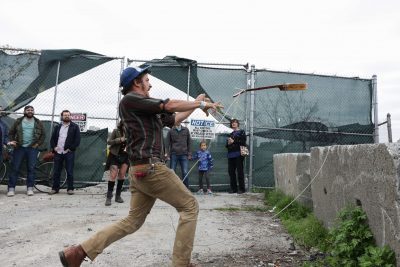Heatwise Yoga (photo by Andrew Bui)
Brooklyn’s yoga scene is heating up (again)
But is hot yoga antithetical to what yoga is supposed to be all about — and is it even good for you?
The first time I tried hot yoga was in 2007 at a Bikram studio in lower Manhattan. There were things I liked about the hot yoga practice: The heat, discovering how flexible I was, sweating out the previous night’s bad decisions. And there were things I didn’t love about it: The heat, discovering how inflexible I was, stringent rules about when to take a sip of water. But, for a couple of years, the city’s various studios’ $25 new-student specials kept me coming back for more every few months when I needed a break from staying out too late and drinking too much.
I abandoned Bikram over a decade ago in favor of a Vinyasa practice, my preference for a “be where you are” mentality and appreciation for what I think of a “slow burn,” overriding my temporary desire to be incredibly uncomfortable for 90 minute stretches, but recently I’ve noticed a new trend in yoga: Vinyasa yoga but make it hot.
‘You will get hot quickly’
Although hot vinyasa yoga hasn’t fully replaced Bikram in Brooklyn, these days it’s easier to find a hot yoga studio offering Vinyasa style yoga — where poses, or asanas, are linked together in a flowing sequence with a focus on the breath — than a Bikram studio.
To be sure, Bikram yoga, founded by Bikram Choudhury, who was the center of a sexual harassment scandal that exploded in 2014, is still around, though the practice’s fixed-postures series is no longer the hot yoga du jour, and even those studios still peddling Choudhury’s way of yoga have largely dropped the disgraced founder’s name.
Although hot yoga outside of Bikram isn’t new, it is currently trending with new hot yoga studios opening up all over Brooklyn — and beyond.
“A lot of people are drawn to it for that sort of American/Western [concept of] harder, faster, stronger,” says Teri Gandy-Richardson, owner of Park Slope Yoga. “The more you’re working, the more you’re sweating, the more you’re doing.”
Heatwise’s Brooklyn Heights and Park Slope location proved so popular that the hot yoga studio just opened a third location in the Bowery. Another hot yoga studio, Vera Yoga, is expanding with a new Williamsburg location, joining siblings in Boerum Hill and Tribeca.
Like Vinyasa yoga practiced in a regular old studio that’s heated in the winter and air-conditioned during the summer, a hot yoga practice links poses together in a type of flow that is often fast-moving and rarely ever the same from class to class or from teacher to teacher, but unlike a traditional slow-burning, strength-building Vinyasa practice, hot yoga is designed to make you burn fast and hard. In my experience, proper form and alignment don’t seem as integral to the practice, a consequence of the often-zippy pacing of a 60-minute class.
Co-founder and owner of Kula Yoga (locations in Williamsburg and Soho), Nikki Vilella says the obvious hot yoga draw is instant gratification. In an environment manipulated to be about 98 degrees Fahrenheit and extra humid, “you will get hot quickly and sweat,” Vilella says.
“The current state of our culture is deeply rooted in instant gratification, speed, urgency, and scrolling. At Kula, we admittedly make you sing for your supper, so to speak,” Vilella says, adding that if Kula’s creative flows have become “counter culture to whatever is mainstream and in the moment,” she’s okay with it. “Kula has been around a long time and ridden more than a few waves.”
Samantha Scupp, Heatwise’s founder and CEO, says she likes the sweat factor in addition to all of the benefits hot yoga provides, including, according to Scupp: help with chronic pain and muscle tension, flexibility, circulation, skin purification, stress management, and better sleep. Also, “you’re sort of delirious at the end,” says Scupp. “You walk out [of class] with a high, and that’s really cool.”
James Robinson, a sports medicine physician at Hospital for Special Surgery (HSS) says that regular exercise — regardless of the temperature in which it is performed, can improve sleep and help with stress, in addition to providing physical benefits. “Working out in a hotter environment may burn slightly more calories during exercise,” than a non-regulated room, Dr. Robinson added.
Is it too hot in here?
Beth Dukes, who lives in Kensington, Brooklyn, and is a regular at Sagoya Yoga, which opened just last year, is not a particularly flexible person by her own admission, which is why she has gravitated toward hot yoga over the non-hot variety because it makes certain poses more accessible to her. “When there’s heat in the room, I think it sort of allows the warm-up process to happen a lot more quickly, and I feel like I can kind of open up a little bit more,” says Dukes.
Vilella agrees that warmer environments lend a “natural plasticity to the fascia and the muscles.”
That said, Kula believes in “building heat organically from the inside out,” Vilella says. “While a hot room will naturally make you sweat more, it doesn’t actually mean you are working harder, better, or detoxing more.”
Amanda Sidran, a Brooklyn-based yoga and pilates instructor who teaches several classes at Yogis & Yoginis in Park Slope, isn’t a fan of hot yoga, and says that “manipulating the environment puts you less into your own body and your own breath.” And breath, Sidran points out, is a deeply rooted part of yoga’s history, which is all about tuning into one’s own self.
Gandy-Richardson’s Park Slope Yoga lives on despite its brick and mortar location on Union Street having shuttered during the pandemic. She says her concern with hot yoga is the risk of overstretching. “When your body’s overheated, there’s a danger of going too far.” Gandy-Richardson says this is especially problematic for “people who aren’t really aware of their bodies and what their limits are.”
Sidran agrees. The heated rooms make your body feel warm and loose, speeding up the entire warm-up process; as a result, yogis may be “more likely to go too far.”
Dr. Rikhev Kashyap, a sports medicine physician at Brooklyn’s NewYork-Presbyterian Hospital says while the heat can help loosen muscles and ligaments, “it is possible to overstretch and cause additional injury.”
In fact, it seems clear that a lot of yoga teachers don’t really care for hot yoga, and perhaps don’t even view it as being on the same plane as the Vinyasa classes they’re teaching, but they are also largely diplomatic when the topic comes up.
A flexitarian workout
Hot yoga’s instant gratification stands in sharp contrast to the original point of yoga in the first place, which often tends not to even acknowledge the workout or exercise factor associated with a vigorous Vinyasa flow. But Scupp insists the hot yoga practice isn’t about fitness gains. “We do not focus on it being a workout at all. That’s the complete opposite of our purpose and our mission and everything that we talk about.”
Britton Schey-Helliwell, one of Vera Yoga’s co-founders, in spite of her stake in the game, doesn’t subscribe to the belief that hot yoga provides a better or more rigorous workout. “There are people who like the heat, like a full body sweat, and/or feel like they loosen up easier,” says Schey-Helliwell, adding that it is a matter of personal preference.
Copy on the studio’s website suggests the physical component is a big part of the Vera practice, which articulates a desire to help people “feel better physically, mentally, and emotionally” via an “alignment-informed, athletic, vinyasa sequencing.”
To that end, Vilella thinks hot yoga might be the best choice for “anyone looking for their yoga practice to be their exercise program.”
Scupp says Heatwise welcomes a lot of people who are new to yoga, “people who say things like I can’t touch my toes and I don’t think I’ll ever be able to.” When they find they are able to achieve these milestones, they are amazed, says Scupp.
Meanwhile, at Kula, flexibility is not really the point. “We do a lot of strength training, core stabilization, and look for strength and stability within ranges of motion,” says Vilella who adds that “the goal in the physical format of my class is to liberate the breath and soften the mind.
Gandy-Richardson, who, it’s worth noting, has arms and abs I envy, buries mention of the practice’s physical benefits: “By the nature of how we intentionally use the breath, yoga supports the immune system and nervous system.” Gandy-Richardson says yoga can “promote a sense of order, and calmness and an understanding about the connection to community, and to self.”
Stretching and holding poses strengthens our muscles and bones, says Gandy-Richardson, but these movements also “improve our ability to focus” and, ideally, to “function with more compassion, and awareness in the world — with more grace and less anxiety.”
You might also like 


























